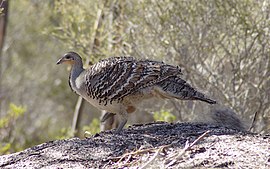Protected area in South Australia
| Yumbarra Conservation Park South Australia | |
|---|---|
| IUCN category VI (protected area with sustainable use of natural resources) | |
 Malleefowl Malleefowl | |
 | |
| Nearest town or city | Ceduna |
| Coordinates | 31°41′S 133°37′E / 31.69°S 133.61°E / -31.69; 133.61 |
| Established | 30 May 1968 (1968-05-30) |
| Area | 3,243.52 km (1,252.3 sq mi) |
| Managing authorities | Department for Environment and Water Far West Coast Aboriginal Corporation |
| Website | Yumbarra Conservation Park |
| See also | Protected areas of South Australia |
Yumbarra Conservation Park, formerly the Yumbarra National Park, is a protected area in the Australian state of South Australia located about 55 kilometres (34 miles) north of the town centre of Ceduna.
To the north it borders Yellabinna Regional Reserve; to the east, Pureba Conservation Park. The conservation park is outside the dog fence, which borders it in the south. Thus, it is situated in the area where dingoes are tolerated. Other animals in the conservation park include southern hairy-nosed wombats, malleefowls, sandhill dunnarts and kangaroos.
The name 'Yumbarra' comes from a prominent rock hole in the area which fills with water after rain, turning into a temporary water hole for the conservation park's wildlife. This particular feature of the rock makes it an important site for birds, and thus bird watching.
The arid landscape is characterised by rolling sand dunes. Googs Track, a 120 km (75 mi) four-wheel drive road connecting the Eyre Highway north of Ceduna to the Trans-Australian Railway near Tarcoola, passes through the conservation park and the Yellabinna Regional Reserve to the north. A few walking trails connect Googs Track with a campsite at Googs Lake, and Mount Finke.
The conservation park is an important habitat for some of Australia's most endangered wildlife species, such as the malleefowl and sandhill dunnart. The conservation park is also home to kangaroos, wombats and dingoes.
A co-management agreement signed by the Far West Coast Aboriginal Corporation and the Government of South Australia in 2013 in respect to the Yumbarra Conservation Park provides for the corporation to give advice on the management of the conservation park and other reserves in the west of the state.

The conservation park is classified as an IUCN IUCN Category VI protected area.
See also
References
- ^ "Terrestrial Protected Areas of South Australia (refer 'DETAIL' tab )". CAPAD 2016. Australian Government, Department of the Environment (DoE). 2016. Retrieved 21 February 2018.
- ^ "Search results for 'Yumbarra Conservation Park' with the following datasets selected - 'NPW and Conservation Properties', 'Suburbs and localities', 'Hundreds', 'Local Government Areas', 'SA Government Regions' and 'Gazetteer'". Location SA Map Viewer. South Australian Government. Retrieved 12 August 2019.
- DeGaris, R.C. (30 May 1968). "NATIONAL PARKS ACT, 1966: NORTH OUT OF HUNDREDS—YUMBARRA NATIONAL PARK DECLARED" (PDF). The South Australian Government Gazette. Government of South Australia. p. 1638. Retrieved 12 August 2019.
Section 457, north out of hundreds, county of Way.
- "Protected Areas Information System - reserve list (as of 16 July 2015)" (PDF). Department of Environment, Water and Natural Resources. Retrieved 3 August 2015.
- ^ "Yumbarra Conservation Park". Department for Environment and Water, South Australia. Retrieved 17 September 2023.
- Hamilton, Jodie and Neindorf, Brooke Family behind Googs Track celebrates 50 years since SA four-wheel drive link was bulldozed ABC News, 16 September 2023. Retrieved 17 September 2023.
- "Co-management of parks in South Australia". Far West Coast Aboriginal Corporation. Retrieved 29 January 2017.
External links
- Yumbarra Conservation Park official webpage
- the Yumbarra Conservation Park webpage on the Protected Planet website